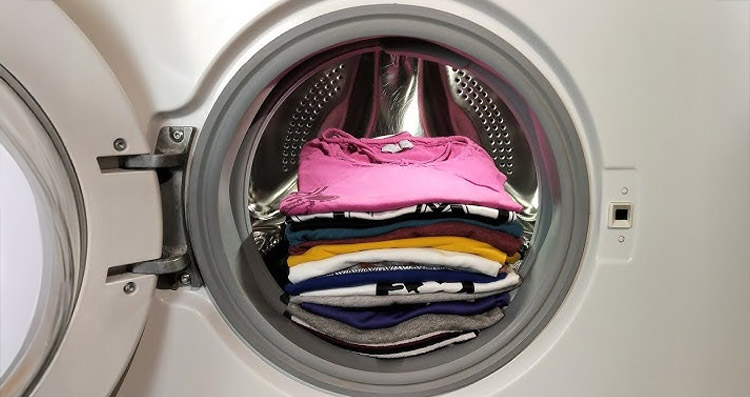How to Care for Printed Garments: Expert Tips

Care for Printed Garments Like a Pro—Your Tees Will Thank You!
You know that moment—you finally get your hands on a brand-new printed T-shirt with a design you love. It looks vivid and eye-catching… until you toss it in the wash. Suddenly, colors dull, vinyl peels, or that once-razor-sharp logo cracks along the edges. Frustrating, right?
We've advised countless groups, from local sports teams to budding streetwear brands, to figure out caring for printed garments. Along the way, we've collected a few tried-and-true techniques that keep prints looking fresh for months (or even years).
In this article, we'll discuss all the secrets of how to wash printed clothes, decode garments care signs, and make sure your threads stay fresh—think months, maybe even years. From sorting laundry like a boss to storing your tees right, we've got you covered with real stories and straight-up tips. Ready to master care for clothes and keep your prints on point? Let's roll!
1. Know Your Print Type: Care for Printed Garments Based on Technique
Before you jump into caring for printed garments, let's figure out what type of print you’re dealing with! Not all designs respond the same way to heat or detergents, so your approach might vary slightly based on the method used.
Common Print Types
- Screen Printing
- Typical Look: Bold, often slightly raised.
- Durability: Generally solid, but hot water or overly harsh scrubbing can fade inks prematurely.
- Care Note: Stick to mild detergents and cooler temperatures for top-notch garments care. This will keep the design vibrant.
- DTF (Direct-to-Film)
- Typical Look: Detailed designs and photo-like prints.
- Durability: Great color range, but the thin adhesive layer can peel if exposed to high heat or harsh chemicals.
- Care Note: Cold or lukewarm water, plus low-heat drying, can prevent peeling and color loss—key for caring for your clothes.
- DTG (Direct-to-Garment)
- Typical Look: Can handle photo-realistic or multi-color designs; ink is applied directly onto the fabric.
- Durability: Good overall, though the ink sits within the fibers and can be more prone to fading with hot washes.
- Care Note: Turn garments inside out and opt for gentle cycles—perfect care for cotton fabric. Hot water can lift DTG ink over time.
- Embroidery
- Typical Look: Threaded, textured logos or letters.
- Durability: Tough, but threads may fray if repeatedly snagged or roughly handled.
- Care Note: Gentle cycle and minimal agitation keep stitches intact.
- Vinyl or Heat Transfer
- Typical Look: Smooth and slightly shiny, can have special finishes (metallic, glitter).
- Durability: Good if cared for, but cracks or peels with repeated hot drying.
- Care Note: Handle with caution—avoid harsh spin cycles or direct ironing on the graphic—care labels for garments matter here!
Mini Anecdote: A local brewery once ordered T-shirts with large, multi-color vinyl logos. After a few staff members washed them on a scorching hot cycle, the corners of the vinyl started curling. Switching to gentle, cold-water settings instantly fixed that meltdown.
2. Pre-Wash Tips: Care for Printed Garments Before Washing
Caring for clothes starts before the wash even spins. Here's how to prep like a pro:
2.1 Sort and Separate (Properly!)
Sorting's not just for neat freaks—it's garments care 101. Toss your black printed tee in with white towels? You're begging for bleed and wrecked designs.
- Color Clusters: Group dark garments together, lights together and brights separately. This helps preserve each item's vibrancy and your print's clarity.
- Fabric Types: Heavier denim or bulky jackets can clash with thin T-shirt prints. Keep them separate whenever possible.
2.2 Check for Stains or Spots in Advance
- Spot Treatment: If you see coffee drips or sweat marks, apply a mild stain remover well away from the printed section. Scrubbing the design vigorously can lift inks, adhesives, or DTG ink layers.
- Identify Print-Specific Cautions: Some printing techniques can't handle powerful cleaning agents. If in doubt, test a hidden corner with mild detergent—garment care instructions aren't always obvious!
Real Note: A band manager once panicked about stage makeup stains on fresh T-shirts. A quick pre-soak in gentle detergent (avoiding the print itself) salvaged them, preserving the rock-star vibe for their entire tour.
3. Wash it the Right Way: Care for Printed Garments Without Fading or Cracking
This is where it all begins! Improper washing is the #1 culprit behind faded prints and cracked designs—luckily, a few easy tweaks can make a huge difference.
3.1 Always Turn T-Shirts Inside Out
Why It Matters: Minimizes direct contact between the design and the washing machine drum or other clothes. By flipping the garment, you prevent heavy friction that could peel or fade your print.
Pro Tip: This habit alone can extend a screen print’s brightness by dozens of washes or keep DTG ink from wearing down prematurely.
3.2 Choose a Gentle Cycle & Mild Detergent
- Cool or Lukewarm Water: High heat is the enemy of most inks, adhesives, and DTG-printed fibers.
- Non-Bleach, Non-Abrasive Detergent: Harsh chemicals might degrade delicate prints.
- No Fabric Softener?: Some performance or moisture-wicking fabrics lose their “breathability” if the softener clogs the fibers.
Mini Anecdote: A community dance group once found their new T-shirts fading just weeks before a big recital. It turned out that they had used a heavily scented, bleach-loaded detergent. Switching to a mild, bleach-free option restored vibrancy and saved the day.
3.3 Avoid Overstuffing the Machine
- Space to Move: If garments are crammed in, friction intensifies, resulting in potential cracking or partial peeling.
- Balanced Load: A balanced load prevents extreme agitation in certain corners of the drum.
4. Drying Hacks: Care for Printed Garments the Smart Way
4.1 Air-Dry for the Win (Whenever Possible)
Spinning a T-shirt on high heat can age a design faster than almost anything else. Air-drying or line-drying is the gentlest approach:
- Hang in Shade: Direct sunlight can bleach colors over time.
- Keep It Inside Out: Prevents dust or UV fading on the printed surface.
Case Study: We collaborated with a local gym that ordered custom tank tops for clients. After shifting to line-drying on their premises, they noticed far fewer complaints about cracking logos—a direct testament to the power of skipping the hot dryer cycle.
4.2 If You Must Use a Dryer, Go Low and Light
- Low or Delicate Setting: Minimizes print damage from scorching.
- Short Timings: Sometimes just a quick partial dry, followed by air-hanging, is enough to remove wrinkles.
- Remove Immediately: Over-drying leads to stiff, brittle prints that can crack when folded or stretched.
5. Ironing & Steaming: Avoiding a Printed T-Shirt Melt-Down
Wrinkles happen, but ironing's tricky with prints. Here's garment care instructions for no meltdowns:
5.1 Flip It Inside Out or Use a Cloth Barrier
- Iron on Reverse: Position the design facing away from the iron’s surface.
- Towel or Pressing Cloth: If you must iron on the design side, place a barrier to diffuse heat.
Tip: Some vinyl, DTF, or DTG prints can warp under steam. To be safe, skip steam or only iron the edges of the garment, steering clear of the logo area.
5.2 Go Low to Medium Heat
- Quick Press: Hover the iron briefly; lingering can melt certain inks or adhesives.
- Avoid Direct Moisture: Steam or water spray might cause bubble-like wrinkles in the design.
Real-World Encounter: A local art collective tried to flatten small wrinkles in their intricately DTG’d tees by pressing them at high heat for too long. The result? Warped outlines and a partial “melt.” Now, they only use a low-heat approach with a protective cloth.
6. Storing Printed Apparel So Designs Stay Fresh
Care for printed garments doesn't stop at drying—storing's key:
6.1 Fold with Care: Avoid Crumpling the Print
- Smooth Out Prints: Ensure you’re not embedding a deep crease across the design. If possible, fold along natural seams instead.
- Keep Heavier Items Off: Stack T-shirts or hoodies in a way that no heavy objects compress the prints for extended periods.
6.2 Pick a Cool, Dry Spot
- No Damp Basements: Moisture can breed mold or discolored splotches.
- Low Light: Overly bright areas (especially direct sunlight) may gradually fade certain inks.
Pro Example: A collector we know keeps limited-edition band T-shirts neatly folded in sealed, breathable bags with silica gel packs. Five years on, the prints still look stage-fresh.
7. Busting Myths About Caring for Printed Garments
Myth #1: “Hot Water Is Always Better for Removing Stains.”
- Truth: Most mild stains lift fine in cooler water with the right detergent. Hot water can degrade adhesive-based prints or cause cotton to shrink.
Myth #2: “Fabric Softeners Enhance Print Lifespan.”
- Truth: Fabric softeners can sometimes break down certain inks or protective coatings, especially on DTF or DTG prints.
Myth #3: “One Washing Method Suits All Print Types.”
- Truth: Screen printing vs. vinyl vs. DTF vs. DTG each have minor differences in how they handle temperature, steam, or friction.
Myth #4: “Sun-Drying Is Perfectly Safe.”
- Truth: While natural drying saves energy, direct sun can fade colors if garments bake in bright light day after day.
Quick Q&A: Your Pressing Questions Answered
We generally advise caution. Some mild spot treatments are fine if you dab gently—avoid heavy scrubbing. When in doubt, test on a small, inconspicuous section or near a seam first.
Once cracks appear, fully reversing them is tough. However, washing in cold water, skipping the dryer, and handling gently can slow further damage. For certain heat-transfer prints, a low-heat iron (with a cloth barrier) may re-adhere minor peels, but it’s not guaranteed.
Typically, no. Bleach might degrade the ink or leave strange outlines around the design. Choose oxygen-based cleaners or spot treatments specifically labeled as safe for printed apparel.
Final Thoughts: Keep Those Prints Looking New for the Long Haul
Caring for printed garments isn't complicated once you know the basics. A few simple habits—like washing in cold water, flipping t-shirts inside out, skipping high-heat drying, and ironing with caution—go a long way toward preserving color and detail. Whether you're sporting a limited-edition band tee, a custom DTG design, or a batch of promotional t-shirts, these guidelines can save you from heartbreak (and extra printing costs).
Key Takeaways
- Turn T-shirts inside out to shield prints from direct friction.
- Wash in cool or lukewarm cycles with mild detergent—avoid bleach unless absolutely necessary.
- Air-dry whenever possible (or use low heat briefly).
- Iron carefully using a protective cloth; never apply high heat directly.
- Store in a cool, dry area, folding neatly around the design.
By following these tips—and ignoring those old wives' tales about “the hotter, the better”—you’ll keep your garments vibrant, crack-free, and fresh-looking. That means more mileage out of your custom designs and less time (and money) wasted replacing them. After all, who wants to bid farewell to a beloved print just because of a few careless wash cycles?


